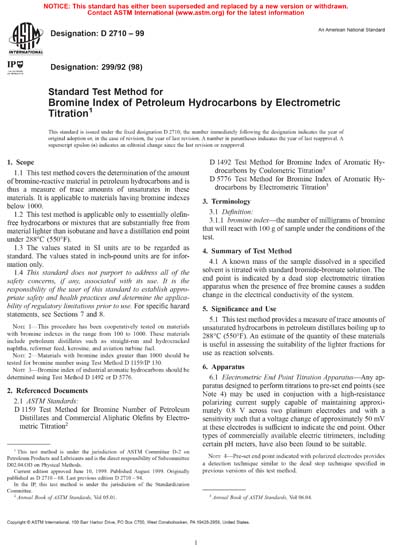Historical
ASTM D2710-99
Standard Test Method for Bromine Index of Petroleum Hydrocarbons by Electrometric Titration
This test method covers the determination of the amount of bromine-reactive material in petroleum hydrocarbons and is thus a measure of trace amounts of unsaturates in these materials. It is applicable to materials having bromine indexes below 1000. 1.2 This test method is applicable only to essentially olefin-free hydrocarbons or mixtures that are substantially free from material lighter than isobutane and have a distillation end point under 288°C (550°F). 1.3 The values stated in SI units are to be regarded as standard. The values stated in inch-pound units are for information only. 1.4 This standard does not purport to address all of the safety concerns, if any, associated with its use. It is the responsibility of the user of this standard to establish appropriate safety and health practices and determine the applicability of regulatory limitations prior to use. For specific hazard statements, see Sections 7, 8, and Annex A3. Note 1-This procedure has been cooperatively tested on materials with bromine indexes in the range from 100 to 1000. These materials include petroleum distillates such as straight-run and hydrocracked naphtha, reformer feed, kerosine, and aviation turbine fuel. Note 2-Materials with bromine index greater than 1000 should be tested for bromine number using Test Method D1159/IP 130. Note 3-Industrial aromatic hydrocarbons should be tested using Test Method D1492. 2. Referenced Documents ASTM Standards: D 1159* Test Method for Bromine Number of Petroleum Distillates and Commercial Aliphatic Olefins by Electrometric Titration D 1492* Test Method for Bromine Index of Aromatic Hydrocarbons by Coulometric Titration
ASTM International [astm]

